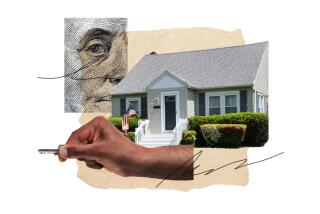Minorities’ Home Ownership Booms Under Clinton but Still Lags Whites’
- Share via
It’s one of the hidden success stories of the Clinton era. In the great housing boom of the 1990s, black and Latino homeownership has surged to the highest level ever recorded. The number of African Americans owning their own home is now increasing nearly three times as fast as the number of whites; the number of Latino homeowners is growing nearly five times as fast as that of whites.
These numbers are dramatic enough to deserve more detail. When President Clinton took office in 1993, 42% of African Americans and 39% of Latinos owned their own home. By this spring, those figures had jumped to 46.9% of blacks and 46.2% of Latinos.
That’s a lot of new picket fences. Since 1994, when the numbers really took off, the number of black and Latino homeowners has increased by 2 million. In all, the minority homeownership rate is on track to increase more in the 1990s than in any decade this century except the 1940s, when minorities joined in the wartime surge out of the Depression.
This trend is good news on many fronts. Homeownership stabilizes neighborhoods and even families. Housing scholar William C. Apgar, now an assistant secretary of Housing and Urban Development, says that research shows homeowners are more likely than renters to participate in their community. The children of homeowners even tend to perform better in school. Most significantly, increased homeownership allows minority families, who have accumulated far less wealth than whites, to amass assets and transmit them to future generations.
What explains the surge? The answer starts with the economy. Historically low rates of minority unemployment have created a larger pool of qualified buyers. And the lowest interest rates in years have made homes more affordable for white and minority buyers alike.
But the economy isn’t the whole story. As HUD Secretary Andrew Cuomo says: “There have been points in the past when the economy has done well but minority homeownership has not increased proportionally.” Case in point: Despite generally good times in the 1980s, homeownership among blacks and Latinos actually declined slightly, while rising slightly among whites.
All of this suggests that Clinton’s efforts to increase minority access to loans and capital also have spurred this decade’s gains. Under Clinton, bank regulators have breathed the first real life into enforcement of the Community Reinvestment Act, a 20-year-old statute meant to combat “redlining” by requiring banks to serve their low-income communities. The administration also has sent a clear message by stiffening enforcement of the fair housing and fair lending laws. The bottom line: Between 1993 and 1997, home loans grew by 72% to blacks and by 45% to Latinos, far faster than the total growth rate.
Lenders also have opened the door wider to minorities because of new initiatives at Fannie Mae and Freddie Mac--the giant federally chartered corporations that play critical, if obscure, roles in the home finance system. Fannie Mae and Freddie Mac buy mortgages from lenders and bundle them into securities; that provides lenders the funds to lend more.
In 1992, Congress mandated that Fannie and Freddie increase their purchases of mortgages for low-income and medium-income borrowers. Operating under that requirement, Fannie Mae, in particular, has been aggressive and creative in stimulating minority gains. It has aimed extensive advertising campaigns at minorities that explain how to buy a home and opened three dozen local offices to encourage lenders to serve these markets. Most importantly, Fannie Mae has agreed to buy more loans with very low down payments--or with mortgage payments that represent an unusually high percentage of a buyer’s income. That’s made banks willing to lend to lower-income families they once might have rejected.
But for all that progress, the black and Latino homeownership rates, at about 46%, still significantly trail the white rate, which is nearing 73%. Much of that difference represents structural social disparities--in education levels, wealth and the percentage of single-parent families--that will only change slowly. Still, Apgar says, HUD’s analysis suggests there are enough qualified buyers to move the minority homeownership rate into the mid-50% range.
The market itself will probably produce some of that progress. For many builders and lenders, serving minority buyers is now less a social obligation than a business opportunity. Because blacks and Latinos, as groups, are younger than whites, many experts believe they will continue to lead the housing market for years.
But with discrimination in the banking system not yet eradicated, maintaining the momentum of the 1990s will also require a continuing nudge from Washington. One key is to defend the Community Reinvestment Act, which the Senate shortsightedly voted to retrench recently. Clinton has threatened a veto if the House concurs.
The top priority may be to ask more of Fannie Mae and Freddie Mac. The two companies are now required to devote 42% of their portfolios to loans for low- and moderate-income borrowers; HUD, which has the authority to set the targets, is poised to propose an increase this summer. Although Fannie Mae actually has exceeded its target since 1994, it is resisting any hike. It argues that a higher target would only produce more loan defaults by pressuring banks to accept unsafe borrowers. HUD says Fannie Mae is resisting more low-income loans because they are less profitable.
Barry Zigas, who heads Fannie Mae’s low-income efforts, is undoubtedly correct when he argues, “There is obviously a limit beyond which [we] can’t push [the banks] to produce.” But with the housing market still sizzling, minority unemployment down and Fannie Mae enjoying record profits (over $3.4 billion last year), it doesn’t appear that the limit has been reached.
All signs point toward a high-velocity collision this summer between two strong-willed protagonists: HUD’s Cuomo and Fannie Mae CEO Franklin D. Raines, the first African American to hold the post. Better they reach a reasonable agreement that provides more fuel for the extraordinary boom transforming millions of minority families from renters into owners.
*
See current and past Brownstein columns on The Times’ Web site at: https://www.latimes.com/brownstein
More to Read
Get the L.A. Times Politics newsletter
Deeply reported insights into legislation, politics and policy from Sacramento, Washington and beyond. In your inbox twice per week.
You may occasionally receive promotional content from the Los Angeles Times.










